Renewable energy
![]()
This article is about energy sources. For the corresponding magazine, see Renewable Energy. The magazine.
Renewable energies (also capitalized: renewable energies) or regenerative energies are energy sources that are practically inexhaustible in the human time horizon for sustainable energy supply or are renewed relatively quickly. This distinguishes them from fossil energy sources, which are finite or regenerate only over a period of millions of years. Alongside the efficient use of energy, renewable energy sources are regarded as the most important pillar of a sustainable energy policy and the energy transition. They include bioenergy (biomass potential), geothermal energy, hydropower, ocean energy, solar energy and wind energy. They draw their energy from the nuclear fusion of the sun, which is by far the most important source of energy, from the kinetic energy of the earth's rotation and planetary motion, and from the earth's internal heat.
In 2018, renewable energies covered 17.9 % of global final energy consumption. Traditional biomass, used for cooking and heating in developing countries, accounted for the largest share at 6.9%. This was followed by modern biomass and solar and geothermal (4.3%), hydropower (3.6%), other modern renewables such as mainly wind and solar PV (together 2.1%) and biofuels (1%). The expansion of renewable energies is being driven forward in many countries around the world. The share of global final energy consumption is increasing only slowly by an average of 0.8 % per year between 2006 and 2016.
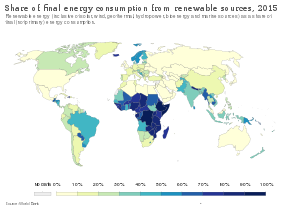
Share of renewable energies in final energy consumption (2015)

Examples of the use of renewable energy sources: biogas, photovoltaics and wind energy
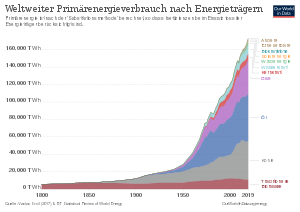
Global primary energy consumption by energy source (fossil, renewable and nuclear) in TWh.
Renewable energy sources
The terms "renewable energies" and "energy sources" are not to be understood in the sense of physics, because energy can neither be destroyed nor created according to the law of conservation of energy, but merely converted into different forms. Secondary energy sources (electricity, heat, fuel) derived from renewable energy sources are also often imprecisely referred to as renewable energy sources. The term renewable heat is also used to refer to thermal energy derived from geothermal, solar thermal, or bioenergy, and to the indirect use of solar energy through solar architecture. Electricity from renewable energy sources is also referred to as green electricity and green power.
In this sense, it would be correct to speak of renewable primary energy sources that are fed by long-lasting processes. The basis for renewable energies is formed by the three energy transformations of nuclear fusion in the sun, radioactive decay in the earth's interior in the case of deep geothermal energy and, in the case of tidal power, the movement of celestial bodies in the gravitational field. By far the most productive form is solar energy, whose annual energy supply on Earth amounts to 3,900,000 EJ (exajoules). Geothermal energy provides 996 EJ, while gravity provides 94 EJ.
The solar energy irradiated onto the Earth is more than ten thousand times the current human energy demand. Geothermal energy and tidal power provide significantly smaller, but in comparison to human demand, high contributions. From a purely physical point of view, there is thus a multiple of the energy available that will be needed in the foreseeable future, even if the theoretical potential mentioned here is reduced by technical and ecological concerns, among other things. The necessary technologies as well as the concepts for the realization of a sustainable energy supply are also considered to be available.
In its WEO 2020, the International Energy Agency (IEA) assumes that almost 40 % of electricity demand worldwide will be met by renewable energies by 2030, with photovoltaics as the central driver (estimated 13 % growth p.a. from 2020-2030). According to an IPCC report from 2012, under optimistic assumptions as much as 77 % of the global primary energy supply could come from renewable energies by 2050.
Solar energy (radiant energy)
→ Main article: Solar energy
The sun emits large amounts of energy that reach the earth as solar radiation (electromagnetic wave). The power radiated by the sun to the earth is approximately 174 PW (petawatts). About 30 % of the radiation is reflected, so that about 122 PW reach the earth (earth's envelope and surface). That is about 1,070 EWh (exawatt hours) per year and thus currently about 7,500 times the world's annual energy demand.
Solar energy can be used directly or indirectly in many ways. Direct use takes place with photovoltaic systems and as solar heat. In addition, the solar energy absorbed by the atmosphere and the earth's surface "supplies" mechanical, kinetic and potential energy. Potential energy is generated when atmospheric processes transport water to higher altitudes. Solar energy also generates winds in the atmosphere through meteorological processes. These winds (= moving air masses) contain kinetic energy (wind energy); they generate waves on the seas (wave energy). Plants absorb the radiation in the course of photosynthesis and fix it in biomass, which can be used for energy conversion. The use of ambient heat by means of heat pumps with near-surface geothermal heat collectors or air-to-air heat pumps also counts as solar energy.
In principle, in addition to direct use, the sun's energy can also be utilized indirectly in the form of bioenergy, wind energy and hydropower. Possible forms of use are:
- Solar energy
- Photovoltaics (photovoltaic system)
- Solar thermal energy (solar collector, solar district heating, solar thermal power plant)
- Solar Chemistry
- Upwind Power Station
- Bioenergy (from biomass in various forms, see articles biogenic fuel and biofuel)
- Wood
- Vegetable oil
- Biodiesel
- Bioethanol and cellulosic ethanol
- Biogas
- BtL fuels
- Biohydrogen
- Muscle power (walking, bicycle, trolley, potter, treadmill, draught animals)
- Hydropower
- Dams and dam walls
- Run-of-river power stations, water mills, current buoys
- wave energy of the sea
- flow energy of the sea
- Sea heat
- Osmosis power plant (different salt content of fresh and salt water)
- Gnepfe (hammer works)
- Bucket wheels, water art, hydraulic ram
- Wind energy
- Wind turbine
- Flugwindkraftwerk
- Windmills
- Sailing ship
Geothermal energy
→ Main article: Geothermal energy
The heat stored in the Earth's interior comes on the one hand from residual heat from the time of the Earth's formation. On the other hand, nuclear decay processes of primordial radionuclides and the friction between the solid earth's crust and the liquid earth's core caused by tidal forces continuously generate further heat. This heat can be used for heating purposes (mainly near-surface geothermal energy) or for electricity generation (mostly deep geothermal energy).
In Germany, Austria and Switzerland, mainly low-enthalpy reservoirs are found. In these reservoirs, however, heat does not flow from the deeper layers to the same extent as it is extracted by a geothermal plant, so that the area of the extraction point cools down and extraction is only possible over a limited period of several decades, after which regeneration of the heat reservoir becomes necessary. However, near-surface systems can be replenished in summer with thermal energy from cooling processes by reversing the direction of transport of the energy. Geothermal projects require careful exploration and analysis of the geological conditions, as interventions in the strata structure can have serious consequences.
Planetary motions and gravity
The force of attraction (gravity) of the sun and moon (and other celestial bodies) causes tides in and on the rotating earth, whereby the rotational speed of the earth is gradually slowed down by this transformation of energy. The resulting induced currents can be used as mechanical energy in tidal power plants and ocean current power plants. These attractive forces also lead to deformations of the Earth's body and thus to friction in the solid Earth and in the liquid Earth's core, which adds further heat to the Earth's interior. The frictional power is about 2.5 TW (terawatts), and the economically usable potential is estimated at about 9 % of this power. Mechanical energy is also generated in this context, however, through interaction with the weather, whose energy is used indirectly by hydroelectric and wind power plants.

Use of wind energy by wind turbines
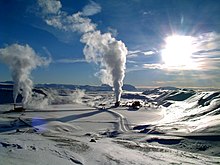
Geothermal power plant in Krafla, Iceland
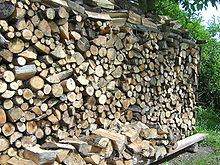
Wood is probably the longest-used carrier of renewable energy
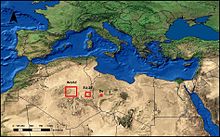
Theoretical space required for solar collectors to generate the electricity demand of the world, Europe (EU-25) or Germany in solar thermal power plants
Integration of renewable energies into the energy system
In the power grid, generation corresponds to consumption at any point in time, since the grid does not store electrical energy. Local imbalances initially lead to small deviations from the nominal voltage, which not only causes balancing power flows between the sub-grids, but also a decreasing grid frequency, as rotating electrical machines supply more power or draw less power than corresponds to the drive or load torque (in power plants or in consumers). Active grid control and the provision of control power keep the subgrids in phase and the frequency constant within narrow limits. In connection with the expansion of renewable energies, the need for control reserve is the subject of controversial debate.
To enable high shares of electricity from renewable energies in the supply, various measures can be used individually or in combination. Studies, for example by Fraunhofer IWES on behalf of the BEE (December 2009), show that a reliable power supply is possible in this way.
These measures include, for example, the stabilisation of electricity generation from renewable energies, the expansion of electricity grids, the creation of intelligent generation and consumption structures, and the (expansion) of electricity storage facilities. While some measures, such as the expansion of electricity grids, make sense even with comparatively low shares of fluctuating generators, other measures, such as the construction of storage power plants to avoid unnecessary energy losses and costs, are only necessary with high shares.
A mix of different renewable energy sources is also necessary, as different renewable energies complement each other. In Germany, for example, there is a potential of more than 1,000 GW for photovoltaics, which could produce around 1,000 TWh of electrical energy per year; significantly more than the current German electricity demand. However, since this would produce large surpluses, especially in the midday hours of sunny days, and enormous storage capacities would have to be built up, such a strong expansion of only one technology does not make sense and the combination with other renewable energies is considerably more expedient. Wind energy and photovoltaics have the greatest potential for electricity generation in Germany, followed at a considerable distance by biomass.
Change of the energy system
→ Main article: Energiewende
The shift from conventional energy supply to renewable energies is massively changing the structure of the energy industry. Electricity generation in large power plants (nuclear, lignite and hard coal power plants) is stagnating or decreasing; generation in plants with a few kilowatts (for example photovoltaics) to a few megawatts has increased. In addition, within a short period of time (since about 2012), a divestment movement has emerged that has been very influential in the public debate and that seeks to achieve the switch to climate-neutral energy sources by selling stakes in fossil energy companies and thus by fundamentally breaking with the conventional energy system.
Another important aspect of decentralised energy supply is the shortening of transport routes or the avoidance of transports (of fuels such as heating oil, natural gas, coal). Various infrastructures such as oil and gas pipelines are also not necessary, or are necessary to a lesser extent. This is especially true for the use of biomass, which can be provided locally. In addition, small power plants facilitate so-called combined heat and power (CHP), in which the generation of electricity is combined with the use of waste heat, for example for heating purposes, thus increasing the overall efficiency. In large power plants, on the other hand, waste heat is often not used. Decentralised energy supply also strengthens the regional economy by creating jobs in the installation, operation and maintenance of the plants.
A major advantage of the decentralized energy transition is that it can be implemented more quickly. Because the plants are smaller and therefore do not require large investments, according to their proponents, a faster expansion of renewable energies is possible than with an energy transition based on large structures. At the same time, there would be more competition on the energy market due to the many different players. Since large-scale projects, on the other hand, would have to be built primarily by well-funded companies such as the established energy corporations, which would have no interest in a rapid expansion of renewable energies due to the competitive situation with existing power plants, no rapid transformation of the energy supply could be expected from this side.
However, not every region has the potential for energy self-sufficiency. On the other hand, in some regions the production, for example of electricity with wind turbines in northern Germany, temporarily or frequently outweighs the local demand, so that the electricity grids to the consumers have to be expanded.
In particular, concepts for a completely self-sufficient energy supply are criticized. Particular emphasis is placed here on security of supply through wide-ranging networks through which oversupply and shortage in different regions can balance each other out. For example, a surplus of solar power from Mediterranean countries would be supplied in summer, while wind power from northern and western Europe could be used in winter. Many proponents of decentralized energy supply, such as Canzler and Knie, also assume that self-consumption and decentralized solutions will play an important role in the future, but that self-sufficiency will only be achieved in the rarest of cases.
However, the conversion of energy supply to sustainability does not necessarily mean exclusively decentralized supply. Some concepts, such as offshore wind farms and solar farm power plants, also rely on centralized generation and large-scale distribution for renewable energies. One example of such a large-scale project was the DESERTEC project planned from 2009 to 2014. Studies by the German Aerospace Center (DLR) showed that less than 0.3% of the available desert areas in North Africa and the Middle East could be used by solar thermal power plants to generate enough electricity and drinking water to meet the growing demand of these countries as well as Europe. In the Mediterranean countries alone, 500,000 km², which corresponds to 6 % of the area of these countries, could produce four times the world's electricity at the end of the 1990s. Harnessing the trade winds in southern Morocco is expected to complement solar power generation. The plan according to which Africa's deserts were to make a considerable contribution to Europe's electricity supply is now only being pursued by Desertec on a smaller scale.
There are currently other projects in the pipeline that can contribute to climate protection. Examples include Gobitec, where solar and wind power from Mongolia is to be supplied to the densely populated and industrially highly developed areas of eastern China, Korea and Japan, and the proposal by the Australian National University in Canberra to supply Southeast Asia with North Australian solar power. Concepts for the construction of a global grid are also being evaluated, with the aim of smoothing out the fluctuating generation of renewable energies and the varying demand for electricity and thus minimising the necessary storage requirements. With electricity transmission using HVDC technology and a voltage of 800 kV, losses of less than 14 % occur at transport distances of 5,000 km. The investment costs for the power lines themselves are forecast at 0.5 to 1 ct/kWh.
Today, it is assumed that the future energy supply will probably consist of a mixture of decentralised and centralised concepts. It is considered certain that the transformation of the energy supply can be achieved neither exclusively through local small-scale systems nor through large-scale structures, but that a mix of both variants is required.
Sector coupling
→ Main article: Sector coupling
The linking of the different areas of energy supply (electricity, heat and transport) opens up further design possibilities for energy production and supply.
For this purpose, instead of slowing down the expansion of renewable energies, an accelerated expansion is required in order to be able to provide additional quantities of electricity for the transport and heat sectors as well, although sector coupling cannot be equated with 100 % electrification. For example, heat storage and intelligent consumption of renewable heat energies (solar thermal, geothermal, bioenergy) can contribute to the temporal adjustment of electricity demand to fluctuating generation.
In 2017, 10.1 % of final energy consumption in the heating sector, 3.3 % in the transport sector and 26.4 % in the electricity sector was covered by renewable energy. Renewable electricity had a share of 1.9 % in the heating sector and 0.3 % of final energy consumption in the transport sector.
For the electricity and heat supply sectors, the Fraunhofer Institute for Solar Energy Systems ISE calculated in 2012 in a scenario for approximately the year 2050 that the total costs for the construction, maintenance and financing of an electricity and heat supply in Germany based on 100 % renewable energies would not be higher than the costs of the current supply.
Energy storage
→ Main article: Energy storage and storage power plant
The greater the share of renewable energies, the greater the importance of storage options in order to match the fluctuations in energy generation to the fluctuations in energy consumption and thus to establish security of supply. In the literature, it is assumed that additional storage facilities will be required to a greater extent from a renewable energy share of approx. 40 %, with the figure of 70 % also being mentioned in isolated cases. Long-term storage, such as power-to-gas technology, is only needed from a share of 70-80 %. Below 40 % renewable energies, balancing by thermal power plants as well as a slight reduction of generation peaks of renewable energies is a more efficient option for balancing. Therefore, additional commercial storage facilities in Germany are not considered necessary until 2020 at the earliest.
In its special report 100 % renewable electricity supply by 2050: climate-friendly, secure, affordable of May 2010, the German Advisory Council on the Environment (Sachverständigenrat für Umweltfragen), appointed by the German government, affirms that the capacities in pumped storage power plants, especially in Norway and Sweden, are by far sufficient to compensate for fluctuating energy supply - especially from wind power plants. It should be noted, however, that this would require the construction of ultrahigh-voltage lines (colloquially referred to as electricity highways) on a much larger scale than is currently envisaged in the grid development plan.
Some of the development of economic storage power plants is still in the early stages. Storage options include:
- Pumped storage power plants use electricity to pump water uphill during storage. When electricity is needed again, the water flows back down and drives a generator. Pumped storage power plants are currently used as large-scale plants due to their relatively low price. Norway in particular has great potential for expansion, which means it could play an important role in electricity storage in Europe, provided suitable low-loss power lines (HVDCs) are laid to Europe.
- Accumulators: Accumulators and redox flow cells store electricity electrochemically. Prices are falling sharply, making these storage devices increasingly interesting. Potential areas of application are in households, e.g. in the form of solar batteries, while large-scale battery storage power plants are a possibility. The first plants are already being used for the short-term provision of system services.
- Heat storage: Solar heat is used to heat water, or excess electricity is used to pump water into warm layers underground to heat it naturally. This can be used to heat buildings, enabling them to use heat from the day at night or heat from the summer in the winter, or for time-delayed electricity generation in solar thermal power plants, enabling them to produce electricity from solar energy 24 hours a day.
- Power-to-gas: Electrolysis, possibly supplemented by methanation, can be used to generate hydrogen or methane from temporarily surplus electricity, which can later be used to produce electricity or heat as needed. The renewable gas can be stored in existing underground natural gas storage facilities, the capacity of which would already be sufficient for a full renewable supply today. The efficiency of hydrogen storage is higher than that of methanation. In the case of hydrogen storage, overall electrical efficiencies (electrolysis → storage → reconversion) of 49 to 55 % can be achieved in the long term. In the case of methanation, the overall efficiency for reconversion to electricity in a combined cycle power plant is 39 %. If combined heat and power is used for gas production and reconversion, overall efficiencies of over 60 % are possible.
- Power-to-heat: Surplus electricity is used directly to generate heat for heating systems or hot water, thus replacing fossil fuels. Conversion back into electrical energy only makes sense under certain conditions.
- Thermodynamic storage: In compressed air storage power plants, air is forced into caverns. When needed, the air escapes again, with the air pressure driving a generator. In adiabatic compressed air storage power plants, the heat released during compression is temporarily stored in heat reservoirs and released again during expansion. In this way, an increase in efficiency can be achieved.
- Flywheel storage: Flywheel storage can also be used for short-term storage and for system services. Flywheels are driven by a motor to absorb energy. The flywheel is braked again by a generator to produce electrical energy. The advantage is the very high number of cycles due to very little wear during operation. A disadvantage, on the other hand, is the comparatively high self-discharge, which is why flywheels are used to stabilize power grids and to balance renewable energies over the course of a day.
Steady power generation
→ Main article: Power plant management
The demand for electricity, the so-called load profile, fluctuates strongly over the course of the day. Since electrical energy can only be stored at great expense and with losses, it is provided by power plant management according to demand. In Germany, the base load has so far been provided primarily by lignite-fired and nuclear power plants, while the medium load is covered by hard coal-fired power plants. In the past, the peak load was mainly supplied by gas-fired and pumped-storage power plants, although in the meantime the share of gas-fired power plants in particular has declined due to the increased feed-in of renewable energies.
With increasing shares of electricity from renewable energies, a change in power plant management is necessary. Although geothermal power plants, hydroelectric power plants and biomass power plants are base-load capable and can be controlled like conventional power plants, electricity generation from solar energy and wind, on the other hand, is subject to strong fluctuations that must be compensated for by using controllable power plants or storage facilities. In some cases, however, these fluctuations correlate with the daily or annual load profile. Electricity from solar energy, for example, is supplied at the main times of demand. Electricity from wind energy is generated more in the winter months and can compensate for the reduced yields of solar plants at that time, which means that the combination of these two sources leads to a stabilisation of production when considering the seasonal pattern. However, when considering shorter periods of time, large fluctuations occur that must be compensated for.
In the case of biogas plants, the energy conversion can be postponed for several hours without major losses, and many run-of-river power plants can also reduce their production by several hours by means of surge operation and thus supply electricity mainly at hours of high demand or during periods of low production from wind and solar energy. Photovoltaic and wind power plants can be throttled or completely shut down and restarted within about 30 s (self-test and start-up of a photovoltaic inverter) to a few minutes (larger wind power plants). This is even an advantage over large steam power plants and nuclear power plants, which require several hours to reach full power during start-up. However, unlike biogas plants and conventional power plants, no fuel is saved by shutting down photovoltaic or wind power plants, and thus no costs are avoided. In order to provide larger outputs, combined cycle power plants are also to be increasingly used, as these can react sufficiently to rapid load changes.
In order to cushion fluctuating feed-in quantities, hydropower plants and biogas power plants can be operated for short periods above their average output, which is limited by the supply of water and biomass. Particular importance is attached to flexibilised biogas plants, which can prospectively offer an available balancing potential of around 16,000 MW in total. Within a few minutes, this capacity could be throttled in the event of oversupply in the grid or ramped up in the event of rising demand. By way of comparison, the capacity of German lignite-fired power plants is put at around 18,000 MW by the Federal Network Agency. However, these large fossil-fuel power plants could only provide a few thousand megawatts for short-term balancing of solar and wind power due to their technically induced inertia.
By making the electricity system more flexible, overproduction can be cushioned even if the share of renewable energies increases sharply. This requires a strong flexibilisation of the electricity system and thus a reduction of the so-called "must-run" capacities.
In order to be able to plan the use of the other types of energy, it is important to have the most accurate short- and medium-term forecasts of the expected wind power and solar power. Power plant management can thus better control the power plants that can be regulated in the short term and, above all, in the longer term.
Use of virtual power plants
→ Main article: Virtual power plant
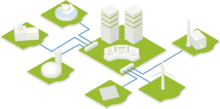
In order to test whether a larger area can be partially or completely supplied with electricity from renewable energies, there are pilot projects that investigate the dynamics and possible applications of so-called combined cycle power plants or virtual power plants. Here, plants from the various renewable energy sectors (water, wind, sun, biogas, etc.) are virtually combined to form a power plant and simulated to cover the exact power demand, for example of a large city. Studies by the TU Berlin and the BTU Cottbus show that such intelligent networking of decentralized regenerative power plants can make a significant contribution to optimally integrating large amounts of fluctuating electricity into the supply network. The studies also showed that the electricity demand and production of a large city like Berlin can be well coordinated with the help of targeted control. Accordingly, this can both relieve the higher grid level and significantly reduce the need for conventional reserve capacities. In October 2013, the research project "Kombikraftwerk 2" concluded with a field test as well as with regional simulations that grid stability can be guaranteed in a fully renewable a secure power supply.
Intelligent power consumption
→ Main articles: Smart power consumption and smart grid
The development of intelligent power grids, so-called smart grids, plays an important role in the restructuring of the electricity supply. With today's information technology, it is possible to temporarily switch off load shedding customers, i.e. temporally flexible electricity consumers such as cement mills, cooling and heating systems, by means of demand side management. Regulation via a time-based electricity price is being considered, similar to so-called low-tariff electricity (night-time electricity). The price would be lowered when there is an oversupply of electricity, but raised when there is a shortage. Intelligent electricity consumers (for example, suitably equipped washing machines, dishwashers, etc.) switch on when the price of electricity is low and switch off when the price of electricity is high. In industry, short-term generation peaks could be temporarily stored and used at a later time. Fluctuations in renewable electricity generation can thus be used in the heating sector or in industrial plants and thus smoothed out instead of being exported. By synchronising consumption in this way, stimulated by dynamising selected electricity price elements, the need for residual peak load as well as backed-up power can be significantly reduced. In private households, heat pumps can also serve to intelligently link the electricity and heating markets. Both systems with and without additional heat storage are possible.
Expansion of electricity grids
With the expansion of wind farms away from the previous generation centres, the structure of grid feed-in is shifting. This requires both the modernisation and expansion of the electricity grids. In particular, this applies to the construction of offshore wind farms, which necessitates the expansion of extra-high voltage lines. By linking regions with high capacities of electricity generation from wind with regions with many hydroelectric or pumped storage power plants, power peaks can also be stored and generation can be stabilised. Intelligent interconnection of several renewable energy sources through virtual power plants and the implementation of smart grids can reduce the need for additional extra-high voltage transmission lines.
Electricity can also be generated in remote regions and transported over long distances to the centres of consumption, for example with offshore wind turbines. Transmission does not take place as alternating current, as is usually the case, but rather with lower losses via high-voltage direct current transmission (HVDC). At an operating voltage of 800 kV, losses of less than 14 % occur with such lines at transport distances of 5,000 km. HVDC systems play a major role in China, where the Hami-Zhengzhou HVDC line with the largest transmission capacity to date (8,000 MW, equivalent to the output of approx. 8-10 large coal-fired power plant units) has been built.
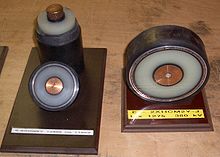
The increased use of underground cables is also being discussed.

Actual electricity generation in Germany on two sunny, windless May days in 2012

According to EWE: Course of early-year electricity consumption (load) over different weekdays and use of base-load, medium-load and peak-load power plants on the load course on weekdays (schematic)
.jpg)
Lower basin of the Langenprozelten pumped storage power station
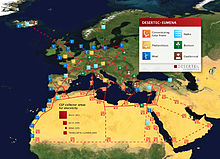
DESERTEC: Outline of a possible infrastructure for a sustainable power supply in Europe, the Middle East and North Africa
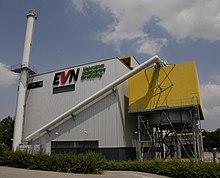
Example of decentralized electricity and heat supply: The Mödling biomass cogeneration plant in Lower Austria
Questions and Answers
Q: What is renewable energy?
A: Renewable energy is energy that comes from renewable resources, such as wind, hydropower, biofuel and solar energy.
Q: How does it differ from fossil fuels?
A: Renewable energy does not produce as many greenhouse gases and other pollutants as fossil fuel combustion.
Q: How long have people been using traditional forms of renewable energy?
A: People have been using traditional forms of renewable energy for centuries all around the world.
Q: Is mass production of electricity with renewable sources becoming more common?
A: Yes, the mass production of electricity using renewable sources is becoming more common.
Q: What are some examples of traditional forms of renewable energy?
A: Examples of traditional forms of renewable energy include wind power, hydropower, biofuel and solar energy.
Q: Are there any negative impacts associated with the use of renewables?
A: While there may be some negative impacts associated with the use of renewables (such as land use changes), they are generally much lower than those associated with fossil fuels.
Search within the encyclopedia